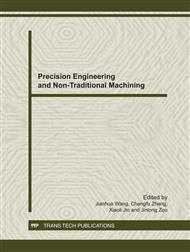p.327
p.331
p.335
p.339
p.344
p.349
p.357
p.361
p.365
The Investigation on the Abrasive Jet to Change the Contact Angle of Solid Material Surface
Abstract:
In order to change surface morphology and contact angle of part, abrasive jet method is discussed in the paper. Glass, steel and titanium are used to study its surface morphology by the processing of abrasive to jet the surface. In addition, the extent of its impact of processing method is studied with different abrasive size. Experiment method and environment are also introduced, and experiment shows that contact angle of glass changes from 14.9° to 93.8° (Titanium and steel also have different degrees of diversification). According to experiment of the method, abrasive jet methods affects contact angle, and it has the value of further research.
Info:
Periodical:
Pages:
344-348
Citation:
Online since:
November 2011
Authors:
Keywords:
Price:
Сopyright:
© 2012 Trans Tech Publications Ltd. All Rights Reserved
Share:
Citation:


